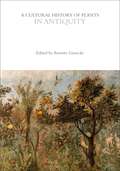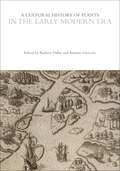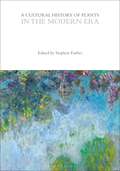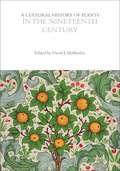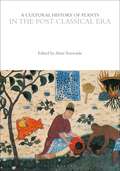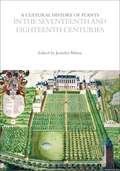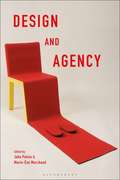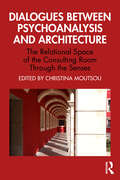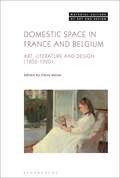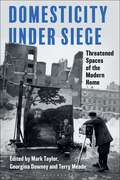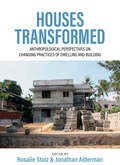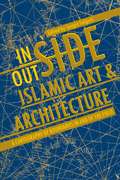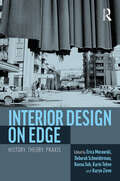- Table View
- List View
A Cultural History of Plants in Antiquity (The Cultural Histories Series)
A Cultural History of Plants in Antiquity covers the period from 10,000 BCE to 500 CE. This period witnessed the transition from hunter-gatherer subsistence to the practice of agriculture in Mesopotamia and elsewhere, and culminated in the fall of the Roman Empire, the end of the Han Dynasty in China, the rise of Byzantium, and the first flowering of Mayan civilization. Human uses for and understanding of plants drove cultural evolution and were inextricably bound to all aspects of cultural practice. The growth of botanical knowledge was fundamental to the development of agriculture, technology, medicine, and science, as well as to the birth of cities, the rise of religions and mythologies, and the creation of works of literature and art. The 6 volume set of the Cultural History of Plants presents the first comprehensive history of the uses and meanings of plants from prehistory to today. The themes covered in each volume are plants as staple foods; plants as luxury foods; trade and exploration; plant technology and science; plants and medicine; plants in culture; plants as natural ornaments; the representation of plants. Annette Giesecke is Professor of Classics at the University of Delaware, USA. Volume 1 in the Cultural History of Plants set.General Editors: Annette Giesecke, University of Delaware, USA, and David Mabberley, University of Oxford, UK.
A Cultural History of Plants in the Early Modern Era (The Cultural Histories Series)
A Cultural History of Plants in the Early Modern Era covers the period from 1400 to 1650, a time of discovery and rediscovery, of experiment and innovation. Renaissance learning brought ancient knowledge to modern European consciousness whilst exploration placed all the continents in contact with one another. The dissemination of knowledge was further speeded by the spread of printing. New staples and spices, new botanical medicines, and new garden plants all catalysed agriculture, trade, and science. The great medical botanists of the period attempted no less than what Marlowe's Dr Faustus demanded - a book “wherein I might see all plants, herbs, and trees that grow upon the earth.” Human impact on plants and our botanical knowledge had irrevocably changed. The 6 volume set of the Cultural History of Plants presents the first comprehensive history of the uses and meanings of plants from prehistory to today. The themes covered in each volume are plants as staple foods; plants as luxury foods; trade and exploration; plant technology and science; plants and medicine; plants in culture; plants as natural ornaments; the representation of plants. Andrew Dalby is an independent scholar and writer, based in France. Annette Giesecke is Professor of Classics at the University of Delaware, USA. Volume 3 in the Cultural History of Plants set.General Editors: Annette Giesecke, University of Delaware, USA, and David Mabberley, University of Oxford, UK.
A Cultural History of Plants in the Modern Era (The Cultural Histories Series)
A Cultural History of Plants in the Modern Era covers the period from 1920 to today - a time when population growth, industrialization, global trade, and consumerism have fundamentally reshaped our relationship with plants. Advances in agriculture, science, and technology have revolutionised the ways we feed ourselves, whilst urbanization and industrial processing have reduced our direct connection with living plants. At the same time, our understanding of both ecology and conservation have greatly increased and our appreciation of the meanings and aesthetics of plants continue to suffuse art and everyday culture. The modern era has witnessed a revolution in both the valuation and the destruction of the natural world - more than ever before, we understand that the vitality of our relationship with plants will shape our future. The 6 volume set of the Cultural History of Plants presents the first comprehensive history of the uses and meanings of plants from prehistory to today. The themes covered in each volume are plants as staple foods; plants as luxury foods; trade and exploration; plant technology and science; plants and medicine; plants in culture; plants as natural ornaments; the representation of plants.Stephen Forbes is an independent scholar and writer, based in Australia. Volume 6 in the Cultural History of Plants set.General Editors: Annette Giesecke, University of Delaware, USA, and David Mabberley, University of Oxford, UK.
A Cultural History of Plants in the Nineteenth Century (The Cultural Histories Series)
A Cultural History of Plants in the Nineteenth Century covers the period from 1800 to 1920, a time of astonishing growth in industrialization, urbanization, migration, population growth, colonial possessions, and developments in scientific knowledge. As European modes of civilization and cultivation were exported worldwide, botanical study was revolutionized – through the work of Charles Darwin and many others – and the new science of biology was born, based on cells, nuclei and molecules. As Darwinism took hold, plants came to be seen as a way of thinking about the connectivity of nature and life itself. The 6 volume set of the Cultural History of Plants presents the first comprehensive history of the uses and meanings of plants from prehistory to today. The themes covered in each volume are plants as staple foods; plants as luxury foods; trade and exploration; plant technology and science; plants and medicine; plants in culture; plants as natural ornaments; the representation of plants. David Mabberley is Emeritus Fellow at Wadham College, University of Oxford, UK; Emeritus Professor at the University of Leiden, The Netherlands; and Adjunct Professor at Macquarie University, Australia. Volume 5 in the Cultural History of Plants set.General Editors: Annette Giesecke, University of Delaware, USA, and David Mabberley, University of Oxford, UK.
A Cultural History of Plants in the Post-Classical Era (The Cultural Histories Series)
A Cultural History of Plants in the Post-Classical Era covers the period from 500 to 1400, ranging across northern and central Europe to the Mediterranean, and from the Byzantine and Arabic Empires to the Persian World, India, and China. This was an age of empires and fluctuating borders, presenting a changing mosaic of environments, populations, and cultural practices. Many of the ancient uses and meanings of plants were preserved, but these were overlaid with new developments in agriculture, landscapes, medicine, eating habits, and art.The six-volume set of the Cultural History of Plants presents the first comprehensive history of the uses and meanings of plants from prehistory to today. The themes covered in each volume are plants as staple foods; plants as luxury foods; trade and exploration; plant technology and science; plants and medicine; plants in culture; plants as natural ornaments; the representation of plants.Alain Touwaide is Scientific Director at the Institute for the Preservation of Medical Traditions, Washington, D.C., USA.A Cultural History of Plants in the Post-Classical Era is the second volume in the six-volume set, A Cultural History of Plants, also available online as part of Bloomsbury Cultural History, a fully-searchable digital library (see www.bloomsburyculturalhistory.com).General Editors: Annette Giesecke, University of Delaware, USA, and David Mabberley, University of Oxford, UK.
A Cultural History of Plants in the Seventeenth and Eighteenth Centuries (The Cultural Histories Series)
A Cultural History of Plants in the Seventeenth and Eighteenth Centuries covers the period from 1650 to 1800,a time of global exploration and the discovery of new species of plants and their potential uses. Trade routes were established which brought Europeans into direct contact with the plants and people of Asia, Oceania, Africa and the Americas. Foreign and exotic plants become objects of cultivation, collection, and display, whilst the applications of plants became central not only to naturalists, landowners, and gardeners but also to philosophers, artists, merchants, scientists, and rulers. As the Enlightenment took hold, the natural world became something to be grasped through reasoned understanding. The 6 volume set of the Cultural History of Plants presents the first comprehensive history of the uses and meanings of plants from prehistory to today. The themes covered in each volume are plants as staple foods; plants as luxury foods; trade and exploration; plant technology and science; plants and medicine; plants in culture; plants as natural ornaments; the representation of plants. Jennifer Milam is Pro Vice-Chancellor and Professor of Art History, University of Newcastle, Australia. Volume 4 in the Cultural History of Plants set.General Editors: Annette Giesecke, University of Delaware, USA, and David Mabberley, University of Oxford, UK.
Cutlery and Plate (Large Print)
This is a picture of some cutlery and a plate. There is a locator dot shown, which will be at the top left of the page when the image is the right way up. In the middle of the page is a round dinner plate. To the left of the plate is a fork with its pointy prongs. Above the plate there is a spoon with its handle on the right of the page. On the right of the plate is a knife - the top part is the blade with sharp teeth on it.
Cutlery and Plate (UEB Contracted)
This is a picture of some cutlery and a plate. There is a locator dot shown, which will be at the top left of the page when the image is the right way up. In the middle of the page is a round dinner plate. To the left of the plate is a fork with its pointy prongs. Above the plate there is a spoon with its handle on the right of the page. On the right of the plate is a knife - the top part is the blade with sharp teeth on it.
Cutlery and Plate (UEB Uncontracted)
This is a picture of some cutlery and a plate. There is a locator dot shown, which will be at the top left of the page when the image is the right way up. In the middle of the page is a round dinner plate. To the left of the plate is a fork with its pointy prongs. Above the plate there is a spoon with its handle on the right of the page. On the right of the plate is a knife - the top part is the blade with sharp teeth on it.
Design and Agency: Critical Perspectives on Identities, Histories, and Practices
Design and Agency brings together leading international design scholars and practitioners to address the concept of agency in relation to objects, organisations and people. The authors set out to expand the scope of design history and practice, avoiding the heroic narratives of a typical modernist approach. They consider both how the agents of design construct and express their identities and subjectivities through practice, while also investigating the distinctive contribution of design in the construction of individual identity and subjectivity. Individual chapters explore notions of agency in a range of design disciplines and historical periods, including the agency of women in effecting changes to the design of offices and working practices; the role of Jeffrey Lindsay and Buckminster Fuller in developing the design of a geodesic dome; Le Corbusier's 'Casa Curutchet'; a re-consideration of the gendered historiography of the 'Jugendstil' movement, and Bruce Mau's design exhibitions. Taken together, the essays in Design and Agency provide a much-needed response to the traditional texts which dominate design history. With a broad chronological span from 1900 to the present, and an equally broad understanding of the term 'design', it expands how we view the discipline, and shows how design itself can be an agent for social, cultural and economic change.
Detached house with garage (Large Print)
This image shows a front view of a detached house with attached garage. There is a locator dot shown, which will be at the top left of the page when the image is the right way up. The pointed tiled roof of the house fills the upper part of the page, with a chimney sticking up towards the right. Down from the roof the upstairs windows are shown: a large one towards the right and a smaller one to its left. Just to the left of the smaller window, the tiled garage roof slopes down above the wide garage door which has a handle towards its lower centre. The door to the house itself is towards the centre at the bottom of the image. The door is glazed at the top, and the letterbox and door knob are shown. There is a narrow window adjoining the door on the garage side. A large window is shown in the lower right of the image, and all the windows have sills.
Detached house with garage (UEB Contracted)
This image shows a front view of a detached house with attached garage. There is a locator dot shown, which will be at the top left of the page when the image is the right way up. The pointed tiled roof of the house fills the upper part of the page, with a chimney sticking up towards the right. Down from the roof the upstairs windows are shown: a large one towards the right and a smaller one to its left. Just to the left of the smaller window, the tiled garage roof slopes down above the wide garage door which has a handle towards its lower centre. The door to the house itself is towards the centre at the bottom of the image. The door is glazed at the top, and the letterbox and door knob are shown. There is a narrow window adjoining the door on the garage side. A large window is shown in the lower right of the image, and all the windows have sills.
Detached house with garage (UEB uncontracted)
This image shows a front view of a detached house with attached garage. There is a locator dot shown, which will be at the top left of the page when the image is the right way up. The pointed tiled roof of the house fills the upper part of the page, with a chimney sticking up towards the right. Down from the roof the upstairs windows are shown: a large one towards the right and a smaller one to its left. Just to the left of the smaller window, the tiled garage roof slopes down above the wide garage door which has a handle towards its lower centre. The door to the house itself is towards the centre at the bottom of the image. The door is glazed at the top, and the letterbox and door knob are shown. There is a narrow window adjoining the door on the garage side. A large window is shown in the lower right of the image, and all the windows have sills.
Dialogues between Psychoanalysis and Architecture: The Relational Space of the Consulting Room Through the Senses
Dialogues between Psychoanalysis and Architecture explores the multisensory space of therapy, real or virtual, and how important it is in providing the container for the therapeutic relationship and process. This book is highly original in bringing psychoanalysis and architecture together and highlighting how both disciplines strive to achieve transformation of our psychic space. It brings together contributions that comprise three parts: the first explores the space of the consulting room through the senses to examine issues such as smell and its link with memory and belonging, hearing out the Other, the psychoanalytic couch, the medical therapy room and the so-called sixth sense; secondly, the book questions how the consulting room can represent or be redesigned to reflect the philosophy that underlies the therapy process, foregrounding an architectural point of view; and thirdly, the book attends to the significance of the consulting room as a virtual space, as it emerged during the pandemic of COVID-19 and beyond. Architectural, psychotherapeutic and interdisciplinary perspectives allow for an important new dimension on the psychological use of space, and will appeal to psychoanalysts, psychoanalytic and integrative psychotherapists, art therapists, students of psychotherapy, as well as architects and designers.
Domestic Space in France and Belgium: Art, Literature and Design, 1850-1920 (Material Culture of Art and Design)
Domestic Space in France and Belgium offers a new addition to the growing body of work in Interior Studies. Focused on late 19th and early 20th-century France and Belgium, it addresses an overlooked area of modernity: the domestic sphere and its conception and representation in art, literature and material culture. Scholars from the US, UK, France, Italy, Canada and Belgium offer fresh and exciting interpretations of artworks, texts and modern homes. Comparative and interdisciplinary, it shows through a series of case-studies in literature, art and architecture, how modernity was expressed through domestic life at the turn of the century in France and Belgium.
Domesticity Under Siege: Threatened Spaces of the Modern Home
Theories of the domestic stemming from the 19th century have focused on the home as a refuge and place of repose for the family, a nurturing environment for children and a safe place for visitors. Under this conception, domestic space is positioned as nurturing and private, a refuge and place of retreat which gave rise to theories of 'home as haven'. While, arguably, some social conditions might suggest this is the case, Domesticity Under Siege exposes a different world, one in which the boundaries of nurturing domesticity collide with both outside and inside agents.Whether these agents are external military forces, psychological trauma or familial violence, they re-position meta-narratives of domesticity, not through identity politics or specialized subgroup experience, but relative to the actions of the world around an inhabited domain. That is, when home is constituted as a private realm, a place where individuals or groups can reside in 'safety and comfort', it is argued as a place in which the individual exercises control or power. However, there are many occasions when forces act upon the home and threaten aspects of safety and comfort, often through such things as ruination, violence, mortality, and infestation.Organised around four thematic sections, 'Microbes, Animals and Insects', 'Human Agents', Wars and Disasters as Agents' and 'Hauntings, Eeriness and the Uncanny', chapters provide a range of approaches to the home which challenge notions of 'haven' and reflect major causes that have played an important role in undermining the modern home. Examples and case studies explore the domestic screen, hoarding, hauntings, violence and imprisonment in the home, wartime interior art, the Hanover Merzbau and Wolfgang Staudte's 1946 film Die Mörder sind unter uns ('The Murderers are Among Us').
Door Key (Large Print)
This picture is of a door key. There is a locator dot shown, which will be at the top left of the page when the image is the right way up. At the top is the handle of the key with a hole in it, and at the bottom is the part of the key that goes into the lock. On the left side of this are the pointed teeth and there is a groove going down to the right.
Door Key (UEB Contracted)
This picture is of a door key. There is a locator dot shown, which will be at the top left of the page when the image is the right way up. At the top is the handle of the key with a hole in it, and at the bottom is the part of the key that goes into the lock. On the left side of this are the pointed teeth and there is a groove going down to the right.
Door Key (UEB Uncontracted)
This picture is of a door key. There is a locator dot shown, which will be at the top left of the page when the image is the right way up. At the top is the handle of the key with a hole in it, and at the bottom is the part of the key that goes into the lock. On the left side of this are the pointed teeth and there is a groove going down to the right.
Houses Transformed: Anthropological Perspectives on Changing Practices of Dwelling and Building
Over the decades, there has been a world-wide transformation of so-called ‘vernacular houses’. Based on ethnographic accounts from different regions, Houses Transformed investigates the changing practices of building houses in a transnational context. It explores the intersection of house biographies and social change, the politics of housing design, the social fabrication of aspirational houses, the domestication of concrete and the intersection of materiality and ontology as well as the rhetoric of the vernacular. The volume provides new anthropological pathways to understanding the dynamics of dwelling in the 21st century.
Igloo (Large Print)
This image shows an igloo from the front. There is a locator dot shown, which will be at the top left of the page when the image is the right way up. The igloo is a dome-shaped structure and fills the page. It is constructed of rectangular blocks of ice fitted together in offset layers like house bricks. The arched entrance is at the end of a short rounded tunnel, and is shown at the lower centre of the image.
Igloo (UEB Contracted)
This image shows an igloo from the front. There is a locator dot shown, which will be at the top left of the page when the image is the right way up. The igloo is a dome-shaped structure and fills the page. It is constructed of rectangular blocks of ice fitted together in offset layers like house bricks. The arched entrance is at the end of a short rounded tunnel, and is shown at the lower centre of the image.
Igloo (UEB uncontracted)
This image shows an igloo from the front. There is a locator dot shown, which will be at the top left of the page when the image is the right way up. The igloo is a dome-shaped structure and fills the page. It is constructed of rectangular blocks of ice fitted together in offset layers like house bricks. The arched entrance is at the end of a short rounded tunnel, and is shown at the lower centre of the image.
Inside/Outside Islamic Art and Architecture: A Cartography of Boundaries in and of the Field
When we walk into a gallery, we have a fairly good idea where the building begins and ends; and inside, while observing a painting, we are equally confident in distinguishing between the painting-proper and its frame and borders. Yet, things are often more complicated. A building defines an exterior space just as much as an interior, and what we perceive to be ornamental and marginal to a given painting may in fact be central to what it represents. In this volume, a simple question is presented: instead of dichotomous separations between inside and outside, or exterior and interior, what other relationships can we think of?The first book of its kind to grapple with this question, Inside/Outside Islamic Art and Architecture focuses on a wide spectrum of mediums and topics, including painted manuscripts, objects, architectural decoration, architecture and urban planning, and photography. Bringing together scholars with diverse methodologies-who work on a geographical span stretching from India to Spain and Nigeria, and across a temporal spectrum from the thirteenth to the twenty-first century-this original book also poses engaging questions about the boundaries of the field.
Interior Design on Edge: History, Theory, Praxis
Interior Design on Edge explores ways that interiors both constitute and upset our edges, whether physical, conceptual or psychological, imagined, implied, necessary or discriminatory.The essays in this volume explore these questions in history, theory, and praxis through a focus on different periods, cultures, and places. Interior Design on Edge showcases new scholarship that expands and contests traditional relationships between architecture, interiors, and the people that use and design them, provoking readers to consider the interior differently, moving beyond its traditional, architectural definition. Focusing on the concept of interiority considered in a wider sense, it draws on interdisciplinary modes of investigation and analysis and reflects the latest theoretical developments in the fields of interior design history and practice.With new research from both established and emerging authors, this volume will make a valuable contribution to the fields of Interior Design, Architecture, Art and Design History, Cultural History, Visual Culture Studies, and Urban Studies.
